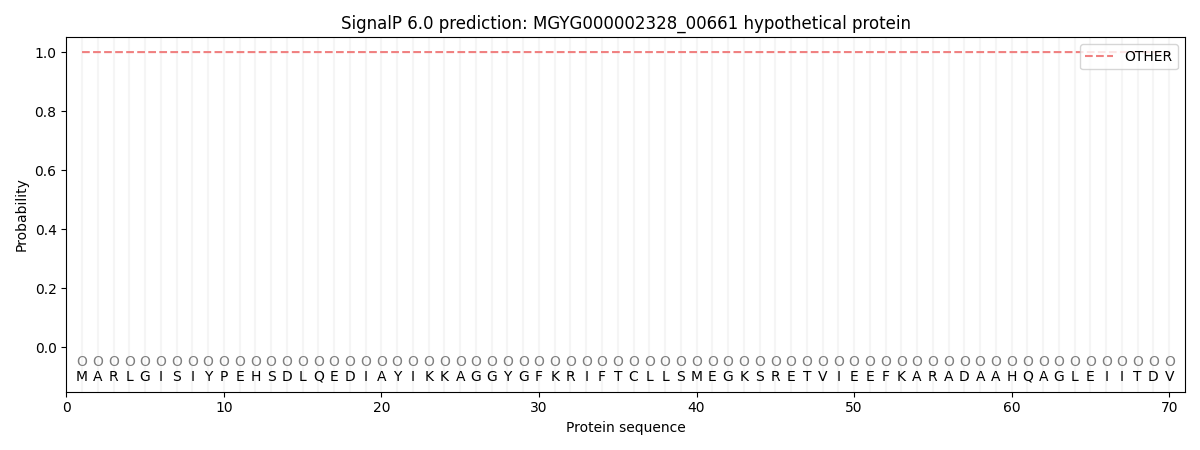You are browsing environment: HUMAN GUT
CAZyme Information: MGYG000002328_00661
You are here: Home > Sequence: MGYG000002328_00661
Basic Information |
Genomic context |
Full Sequence |
Enzyme annotations |
CAZy signature domains |
CDD domains |
CAZyme hits |
PDB hits |
Swiss-Prot hits |
SignalP and Lipop annotations |
TMHMM annotations
Basic Information help
| Species | Enterocloster asparagiformis | |||||||||||
|---|---|---|---|---|---|---|---|---|---|---|---|---|
| Lineage | Bacteria; Firmicutes_A; Clostridia; Lachnospirales; Lachnospiraceae; Enterocloster; Enterocloster asparagiformis | |||||||||||
| CAZyme ID | MGYG000002328_00661 | |||||||||||
| CAZy Family | GH170 | |||||||||||
| CAZyme Description | hypothetical protein | |||||||||||
| CAZyme Property |
|
|||||||||||
| Genome Property |
|
|||||||||||
| Gene Location | Start: 8978; End: 9808 Strand: - | |||||||||||
CAZyme Signature Domains help
| Family | Start | End | Evalue | family coverage |
|---|---|---|---|---|
| GH170 | 3 | 267 | 2.2e-83 | 0.7285714285714285 |
CDD Domains download full data without filtering help
| Cdd ID | Domain | E-Value | qStart | qEnd | sStart | sEnd | Domain Description |
|---|---|---|---|---|---|---|---|
| pfam19200 | DUF871_N | 3.00e-120 | 4 | 241 | 1 | 235 | DUF871 N-terminal domain. This family consists of several conserved hypothetical proteins from bacteria and archaea. The function of this family is unknown. |
| COG3589 | COG3589 | 3.77e-85 | 1 | 268 | 1 | 264 | Uncharacterized protein [Function unknown]. |
| cd11326 | AmyAc_Glg_debranch | 0.007 | 42 | 75 | 101 | 131 | Alpha amylase catalytic domain found in glycogen debranching enzymes. Debranching enzymes facilitate the breakdown of glycogen through glucosyltransferase and glucosidase activity. These activities are performed by a single enzyme in mammals, yeast, and some bacteria, but by two distinct enzymes in Escherichia coli and other bacteria. Debranching enzymes perform two activities: 4-alpha-D-glucanotransferase (EC 2.4.1.25) and amylo-1,6-glucosidase (EC 3.2.1.33). 4-alpha-D-glucanotransferase catalyzes the endohydrolysis of 1,6-alpha-D-glucoside linkages at points of branching in chains of 1,4-linked alpha-D-glucose residues. Amylo-alpha-1,6-glucosidase catalyzes the endohydrolysis of 1,6-alpha-D-glucoside linkages at points of branching in chains of 1,4-linked alpha-D-glucose residues. In Escherichia coli, GlgX is the debranching enzyme and malQ is the 4-alpha-glucanotransferase. TreX, an archaeal glycogen-debranching enzyme has dual activities like mammals and yeast, but is structurally similar to GlgX. TreX exists in two oligomeric states, a dimer and tetramer. Isoamylase (EC 3.2.1.68) is one of the starch-debranching enzymes that catalyzes the hydrolysis of alpha-1,6-glucosidic linkages specific in alpha-glucans such as amylopectin or glycogen and their beta-limit dextrins. The Alpha-amylase family comprises the largest family of glycoside hydrolases (GH), with the majority of enzymes acting on starch, glycogen, and related oligo- and polysaccharides. These proteins catalyze the transformation of alpha-1,4 and alpha-1,6 glucosidic linkages with retention of the anomeric center. The protein is described as having 3 domains: A, B, C. A is a (beta/alpha) 8-barrel; B is a loop between the beta 3 strand and alpha 3 helix of A; C is the C-terminal extension characterized by a Greek key. The majority of the enzymes have an active site cleft found between domains A and B where a triad of catalytic residues (Asp, Glu and Asp) performs catalysis. Other members of this family have lost the catalytic activity as in the case of the human 4F2hc, or only have 2 residues that serve as the catalytic nucleophile and the acid/base, such as Thermus A4 beta-galactosidase with 2 Glu residues (GH42) and human alpha-galactosidase with 2 Asp residues (GH31). The family members are quite extensive and include: alpha amylase, maltosyltransferase, cyclodextrin glycotransferase, maltogenic amylase, neopullulanase, isoamylase, 1,4-alpha-D-glucan maltotetrahydrolase, 4-alpha-glucotransferase, oligo-1,6-glucosidase, amylosucrase, sucrose phosphorylase, and amylomaltase. |
CAZyme Hits help
| Hit ID | E-Value | Query Start | Query End | Hit Start | Hit End |
|---|---|---|---|---|---|
| ASN95847.1 | 1.15e-157 | 1 | 269 | 1 | 269 |
| QRP39378.1 | 1.15e-157 | 1 | 269 | 1 | 269 |
| ANU44542.1 | 6.65e-157 | 1 | 269 | 1 | 269 |
| QIX89835.1 | 6.65e-157 | 1 | 269 | 1 | 269 |
| QJU19892.1 | 7.72e-156 | 1 | 269 | 1 | 269 |
PDB Hits download full data without filtering help
| Hit ID | E-Value | Query Start | Query End | Hit Start | Hit End | Description |
|---|---|---|---|---|---|---|
| 1X7F_A | 7.33e-91 | 3 | 276 | 28 | 299 | Crystalstructure of an uncharacterized B. cereus protein [Bacillus cereus ATCC 14579] |
| 2P0O_A | 1.66e-19 | 2 | 237 | 3 | 232 | Crystalstructure of a conserved protein from locus EF_2437 in Enterococcus faecalis with an unknown function [Enterococcus faecalis V583] |
Swiss-Prot Hits download full data without filtering help
| Hit ID | E-Value | Query Start | Query End | Hit Start | Hit End | Description |
|---|---|---|---|---|---|---|
| A0A0H2XHV5 | 4.35e-07 | 18 | 229 | 13 | 215 | 6-phospho-N-acetylmuramidase OS=Staphylococcus aureus (strain USA300) OX=367830 GN=mupG PE=1 SV=1 |
SignalP and Lipop Annotations help
This protein is predicted as OTHER

| Other | SP_Sec_SPI | LIPO_Sec_SPII | TAT_Tat_SPI | TATLIP_Sec_SPII | PILIN_Sec_SPIII |
|---|---|---|---|---|---|
| 1.000060 | 0.000000 | 0.000000 | 0.000000 | 0.000000 | 0.000000 |
